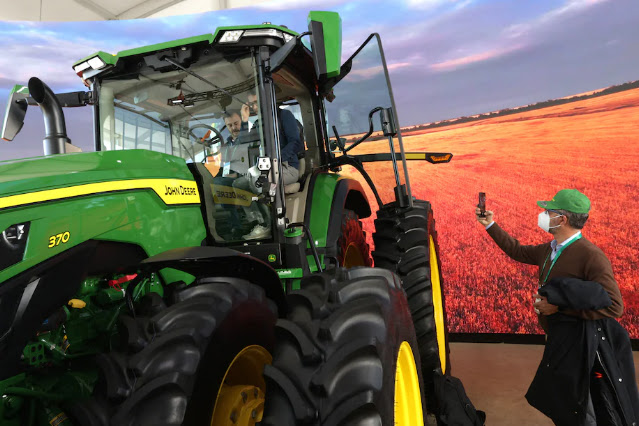 |
| The John Deere 8R autonomous tractor on display at the CES 2022 trade show. (Getty Images photo by Alex Wong) |
The annual Consumer Electronics Show has been wowing audiences with tech innovations since 1967, with notable gadgets such as the CD player, the Nintendo Entertainment System, and the first home VCR all making their debut there. So it may seem odd that this year's headliner was an autonomous John Deere tractor, but "if that seems incongruous, think again. Farm equipment belongs at a technology fair," columnist David Von Drehle writes for The Washington Post. "Arguably, no technology matters more. From the days of the Fertile Crescent, agriculture has pushed technology along."
But, he warns, the trend of automation that's transformed agriculture over the past 75 years presages similar changes in other industries—and America must better manage those changes better than it has with agriculture.
The self-driving tractor—which can be controlled via smartphone app—continues a decades-long trend of automation, Von Drehle writes: "Since 1948, total agricultural output in the United States has more than doubled, while the number of self-employed and family farmworkers has dropped by roughly 75 percent. Put another way: One farmer today does the work of eight agricultural workers in the post-World War II generation. And that’s before the farmerless tractor."
Increasing automation has accentuated the divide between small-scale farmers who often work second jobs off the farm, and large-scale operators who can afford to buy a $500,000 self-driving tractor. "According to a paper by the agricultural economist Jayson Lusk at Purdue University, two-thirds of the nation’s farm output comes from operations with sales above $1 million per year," Von Drehle writes. "As a result, the wealth gap hit farm country early. U.S. spending on foods and fibers is robust, but the money goes into fewer hands." Absentee landowners who rent or sharecrop to small farmers also claim a percentage of the proceeds.
Because of this increasing agricultural wealth gap, "the rural heartland is struggling. Small towns and crossroads have dwindled to almost nothing. Surviving communities struggle to hold on to their young people, whose labor is no longer needed. Rural health care is suffering as hospitals consolidate. School districts are starved for students. County governments serve fewer citizens and therefore provide fewer jobs," Von Drehle writes. "Census data indicate that about 40 percent of Americans lived on a farm in 1900, and today the number is around 1 percent. That’s not because there’s no money in farming — there will be money in farming as long as humans need to eat. It’s because there is so little work left for farmers."
The same trend is hurting the economy as a whole, as other industries automate as fast as they can to maximize profit, he believes. "We cannot hollow out the entire economy as we’ve allowed rural America to be hollowed. We need to become much more sophisticated and much more vigorous about lifelong learning, acquisition of new skills, support for workers in transition (and their families). We need to understand that education is no longer preparation for a career, but preparation for disrupted careers: High school and college graduates must excel in teamwork, skill-building and adaptation," Von Drehle writes. "A species that can go from cast-iron to steel plows, and from there to autonomous tractors, is a problem-solving species. Which is a good thing, because the transformation of developed economies by technology is creating a whole lot of problems. We can do better with eventual, inevitable changes than we’ve done by rural America, but not without constant focus and the willingness to think and act in new ways. The future will not drive itself."
No comments:
Post a Comment